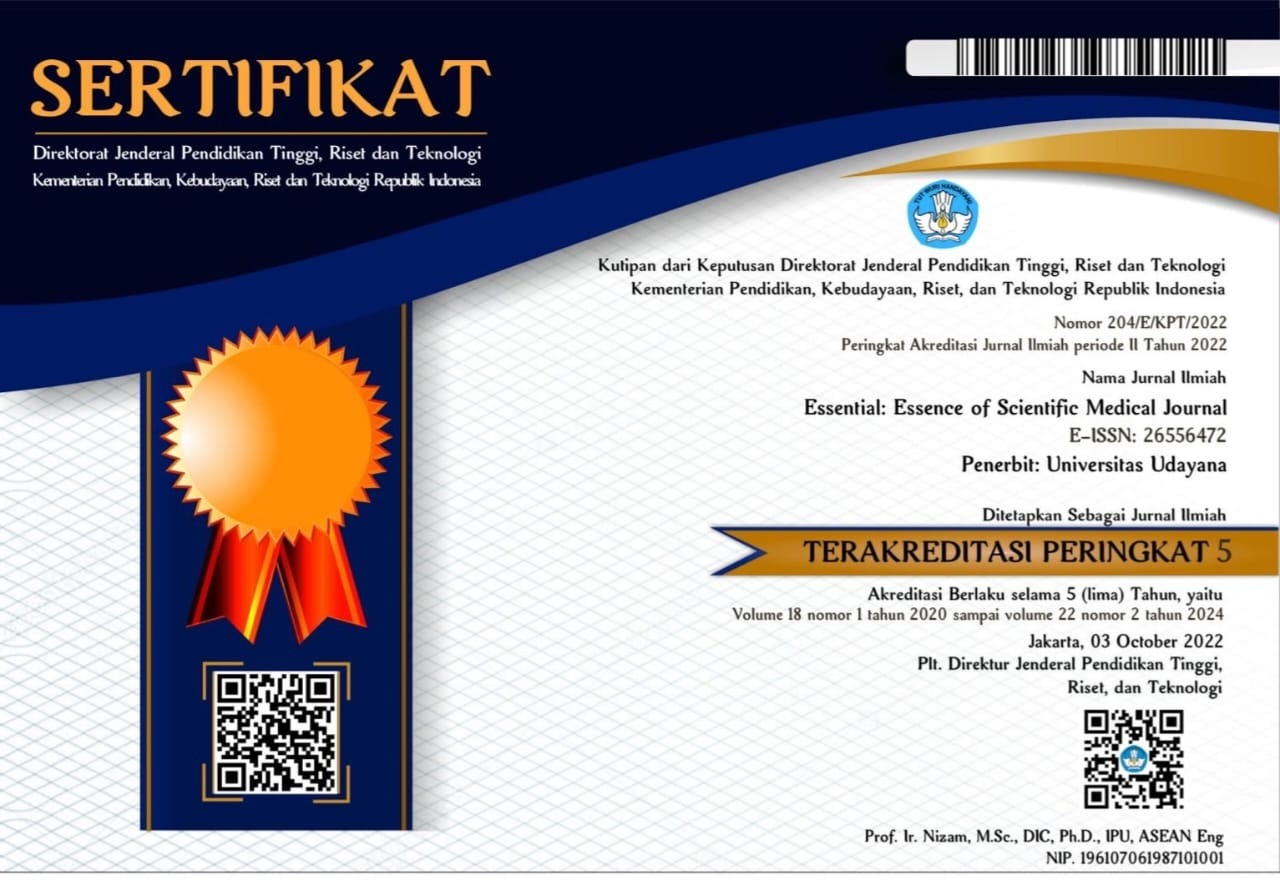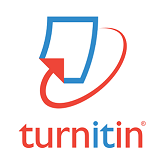POTENSI GASTROPROTEKTIF EKSTRAK BUNGA CENGKIH (Syzygium aromaticum): ANTIULKUS LAMBUNG, ANTIOKSIDAN, ANTIINFLAMASI, DAN ANTIMIKROBA
Abstract
Pendahuluan: Cengkih (Syzygium aromaticum) merupakan salah satu tanaman asli yang berasal dari Indonesia. Kandungan utama bunga cengkih adalah eugenol, ?-kariofilen, dan eugenol asetat. Gangguan pada sistem pencernaan atau gastrointestinal merupakan gejala ataupun penyakit yang menyebabkan ketidaknyamanan pada penderitanya, misalnya dispepsia, gastritis, maag, infeksi, konstipasi, perdarahan, ulkus lambung, dan penyakit degeneratif kronis yang dapat disebabkan oleh obat-obatan, minuman beralkolhol, merokok, makanan asam atau lemak tinggi, dan malnutrisi.
Pembahasan: Aktivitas antiuklus lambung ekstrak bunga cengkih melalui peningkatan faktor protektif lambung seperti sintesis mukus lambung, bikarbonat, regulasi aliran darah mukosa lambung, serta menghibisi asam lambung. Ekstrak bunga cengkih juga berperan sebagai antioksidan dan antiinflamasi dengan mengurangi sitokin proinflamasi, misalnya IL-1?, IL-6, TNF-?, nitrogen oksida, NF-?B dan meningkatkan antioksidan seluler seperti P450 reduktase, superoksida dismutase, katalase, glutathion peroksida, gluthation, dan thiol non-protein. Aktivitas antimikroba ekstrak bunga cengkih meliputi antibakteri, antivirus, antifungi, dan antiprotozoa.
Simpulan: Ekstrak bunga cengkih memiliki berbagai aktivitas biologis, seperti antiulkus lambung, antibakteri, antifungi, antiinflamasi, dan antioksidan.
Introduction: Clove (Syzygium aromaticum) is one of Indonesia’s native plant. The main components of clove bud are eugenol, ?-caryophyllene, dan eugenol acetate. Gastrointestinal symptoms or disease can lead to patient feeling uncomfortable. For examples dyspepsia, gastritis, infection, constipation, bleeding, gastric ulcer, and chronic degenerative disease that may be caused by drugs, alcohol, smoking, acidic or fatty foods, and malnutrition.
Discussion: Clove bud extract has a lot of biological activities such as, antiulcer, antibacterial, antifungal, antiinflammation, and antioxidant. The methods used for this literature review are from 41 journals and electronic databases search. The antiulcer component of clove bud extract works by increasing the gastric protective factor, such as synthetizing gastric mucous, bicarbonate, regulating gastric mucosal blood flow, and inhibiting gastric acid. Clove bud extract also plays a role as antioxidant and antiinflammation by reducing cytokines proinflammation like IL-1?, IL-6, TNF-?, nitrite oxide, NF-?B and enhancing cellular antioxidant, for example P450 reductase, superoxide dismutase, catalase, glutathione peroxidase, glutathione, thiol non-protein. The microbial activity of clove bud extract includes antibacterial, antiviral, antifungal, and antiprotozoal.
Conclusion: Clove bud extract has several biological activity, such as antiulcer, antimicrobial, antibacterial, antifungal, antiinflammation, and antioxidant.
Downloads
References
2. Issac A, Gopakumar G, Kuttan R, Maliakel B, Krishnakumar IM. Safety and anti-ulcerogenic activity of a novel polyphenol-rich extract of clove buds (Syzygium aromaticum L). Food Funct 2015;6(3):842–52.
3. Miftahussurur M, Waskito LA, Fauzia KA, Mahmudah I, Doohan D, Adnyana IK, et al. Overview of Helicobacter pylori Infection in Indonesia: What Distinguishes It from Countries with High Gastric Cancer Incidence? Gut Liver 2021;15(5):653–65.
4. Price AB. Pathology of drug-associated gastrointestinal disease. Br J Clin Pharmacol 2003;56(5):477–82.
5. McEvoy L, Carr DF, Pirmohamed M. Pharmacogenomics of NSAID-Induced Upper Gastrointestinal Toxicity. Front Pharmacol 2021;12.
6. Chen L, Deng H, Cui H, Fang J, Zuo Z, Deng J, et al. Inflammatory responses and inflammation-associated diseases in organs. Oncotarget 2018;9(6):7204–18.
7. Rajput JD, Bagul SD, Pete UD, Zade CM, Padhye SB, Bendre RS. Perspectives on medicinal properties of natural phenolic monoterpenoids and their hybrids. Mol Divers 2018;22(1):225–45.
8. Nurdjannah N. Diversifikasi Penggunaan Cengkeh. Perspektif 2004;3(2):61–70.
9. Santin JR, Lemos M, Klein-Júnior LC, Machado ID, Costa P, de Oliveira AP, et al. Gastroprotective activity of essential oil of the Syzygium aromaticum and its major component eugenol in different animal models. Naunyn Schmiedebergs Arch Pharmacol 2011;383(2):149–58.
10. Parle M, Khanna D. Clove: A champion spice. Int J Res Ayurveda Pharm 2010;2.
11. Shahbazi Y. Antioxidant, antibacterial, and antifungal properties of nanoemulsion of clove essential oil. Nanomedicine Research Journal 2019;4(4):204–8.
12. Behbahani BA, Noshad M, Falah F. Study of chemical structure, antimicrobial, cytotoxic and mechanism of action of Syzygium aromaticum essential oil on foodborne pathogens. Potravinarstvo Slovak Journal of Food Sciences 2019;13(1):875–83.
13. Rajkowska K, Nowak A, Kunicka-Styczyńska A, Siadura A. Biological effects of various chemically characterized essential oils: investigation of the mode of action against Candida albicans and HeLa cells. RSC Adv 2016;6(99):97199–207.
14. El-Darier SM, El-Ahwany AMD, Elkenany ET, Abdeldaim AA. An in vitro study on antimicrobial and anticancer potentiality of thyme and clove oils. Rend Lincei Sci Fis Nat 2018;29(1):131–9.
15. Jung DH, Park MH, Kim CJ, Lee JY, Keum CY, Kim IS, et al. Effect of β-caryophyllene from Cloves Extract on Helicobacter pylori Eradication in Mouse Model. Nutrients 2020;12(4):1000.
16. Machado M, Dinis AM, Salgueiro L, Custódio JBA, Cavaleiro C, Sousa MC. Anti-Giardia activity of Syzygium aromaticum essential oil and eugenol: Effects on growth, viability, adherence and ultrastructure. Exp Parasitol 2011;127(4):732–9.
17. Nuñez L, D’Aquino M. Microbicide activity of clove essential oil (Eugenia caryophyllata). Brazilian Journal of Microbiology 2012;43(4):1255–60.
18. Pinto E, Vale-Silva L, Cavaleiro C, Salgueiro L. Antifungal activity of the clove essential oil from Syzygium aromaticum on Candida, Aspergillus and dermatophyte species. J Med Microbiol 2009;58(11):1454–62.
19. Lane T, Anantpadma M, Freundlich JS, Davey RA, Madrid PB, Ekins S. The Natural Product Eugenol Is an Inhibitor of the Ebola Virus In Vitro. Pharm Res 2019;36(7):104.
20. Dai JP, Zhao XF, Zeng J, Wan QY, Yang JC, Li WZ, et al. Drug Screening for Autophagy Inhibitors Based on the Dissociation of Beclin1-Bcl2 Complex Using BiFC Technique and Mechanism of Eugenol on Anti-Influenza A Virus Activity. PLoS One 2013;8(4):e61026.
21. de Oliveira AS, Gazolla PAR, Oliveira AFC da S, Pereira WL, de S. Viol LC, Maia AF da S, et al. Discovery of novel West Nile Virus protease inhibitor based on isobenzonafuranone and triazolic derivatives of eugenol and indan-1,3-dione scaffolds. PLoS One 2019;14(9):e0223017.
22. Haro-González JN, Castillo-Herrera GA, Martínez-Velázquez M, Espinosa-Andrews H. Clove Essential Oil (Syzygium aromaticum L. Myrtaceae): Extraction, Chemical Composition, Food Applications, and Essential Bioactivity for Human Health. Molecules 2021;26(21):6387.
23. Golmakani MT, Zare M, Razzaghi S. Eugenol Enrichment of Clove Bud Essential Oil Using Different Microwave-assisted Distillation Methods. Food Sci Technol Res 2017;23(3):385–94.
24. Kennouche A, Benkaci-Ali F, Scholl G, Eppe G. Chemical Composition and Antimicrobial Activity of the Essential Oil of Eugenia caryophyllata Cloves Extracted by Conventional and Microwave Techniques. Journal of Biologically Active Products from Nature 2015;5(1):1–11.
25. El-Metwally EM. Evaluation of Antiulcer Activity of Ginger, Clove and Castor Oils Against Aspirin Induced Gastric Ulcers in Rats. World Appl Sci J 2014;29(7):815–24.
26. Ramadan MM, Ali MM, Ghanem KZ, El-Ghorabe AH. Essential oils from Egyptian aromatic plants as antioxidant and novel anticancer agents in human cancer cell lines. Grasas y Aceites 2015;66(2):e080.
27. Rusmana D, Elisabeth M, Widowati W, Fauziah N, Maesaroh M. Inhibition of Inflammatory Agent Production by Ethanol Extract and Eugenol of Syzygium aromaticum (L.) Flower Bud (Clove) in LPS-Stimulated Raw 264.7 Cells. Research Journal of Medicinal Plant 2015;9(6):264–74.
28. Yeh JL, Hsu JH, Hong YS, Wu JR, Liang JC, Wu BN, et al. Eugenolol and Glyceryl-Isoeugenol Suppress LPS-Induced INOS Expression by Down-Regulating NF-κB and AP-1 through Inhibition of Mapks and AKT/IκBα Signaling Pathways in Macrophages. Int J Immunopathol Pharmacol 2011;24(2):345–56.
29. Barboza JN, da Silva Maia Bezerra Filho C, Silva RO, Medeiros JVR, de Sousa DP. An Overview on the Anti-inflammatory Potential and Antioxidant Profile of Eugenol. Oxid Med Cell Longev 2018;2018:1–9.
30. Dahham S, Tabana Y, Iqbal M, Ahamed M, Ezzat M, Majid A, et al. The Anticancer, Antioxidant and Antimicrobial Properties of the Sesquiterpene β-Caryophyllene from the Essential Oil of Aquilaria crassna. Molecules 2015;20(7):11808–29.
31. Zhou L, Zhan ML, Tang Y, Xiao M, Li M, Li QS, et al. Effects of β-caryophyllene on arginine ADP-ribosyltransferase 1-mediated regulation of glycolysis in colorectal cancer under high-glucose conditions. Int J Oncol 2018;
32. Alfikri FN, Pujiarti R, Wibisono MG, Hardiyanto EB. Yield, Quality, and Antioxidant Activity of Clove ( Syzygium aromaticum L.) Bud Oil at the Different Phenological Stages in Young and Mature Trees. Scientifica (Cairo) 2020;2020:1–8.
33. González-Rivera J, Duce C, Falconieri D, Ferrari C, Ghezzi L, Piras A, et al. Coaxial microwave assisted hydrodistillation of essential oils from five different herbs (lavender, rosemary, sage, fennel seeds and clove buds): Chemical composition and thermal analysis. Innovative Food Science & Emerging Technologies 2016;33:308–18.
34. Marmouzi I, Karym EM, Alami R, El Jemli M, Kharbach M, Mamouch F, et al. Modulatory effect of Syzygium aromaticum and Pelargonium graveolens on oxidative and sodium nitroprusside stress and inflammation. Orient Pharm Exp Med 2019;19(2):201–10.
35. Vijayasteltar L, Nair GG, Maliakel B, Kuttan R, I.M. K. Safety assessment of a standardized polyphenolic extract of clove buds: Subchronic toxicity and mutagenicity studies. Toxicol Rep 2016;3:439–49.
36. M. Asali A, Alghamdi MA, Fallatah SA, Alholaily WA, Aldandan RG, Alnosair AH, et al. Risk factors leading to peptic ulcer disease: systematic review in literature. Int J Community Med Public Health 2018;5(10):4617.
37. Min Dong SX. Painting a Complete Picture of the Pathogenesis of Peptic Ulcers. J Ment Health Clin Psychol 2022;6(3):32–43.
38. Yandrapu H, Sarosiek J. Protective Factors of the Gastric and Duodenal Mucosa: An Overview. Curr Gastroenterol Rep 2015;17(6):24.
39. JIN SE, LEE MY, SHIN IS, JEON WY, HA H. Syzygium aromaticum water extract attenuates ethanol-induced gastric injury through antioxidant effects in rats. Mol Med Rep 2016;14(1):361–6.
40. Takeuchi K, Amagase K. Roles of Cyclooxygenase, Prostaglandin E2 and EP Receptors in Mucosal Protection and Ulcer Healing in the Gastrointestinal Tract. Curr Pharm Des 2018;24(18):2002–11.
41. Sharma JN, Al-Omran A, Parvathy SS. Role of nitric oxide in inflammatory diseases. Inflammopharmacology 2007;15(6):252–9.
42. Kirkby NS, Chan M V., Zaiss AK, Garcia-Vaz E, Jiao J, Berglund LM, et al. Systematic study of constitutive cyclooxygenase-2 expression: Role of NF-κB and NFAT transcriptional pathways. Proceedings of the National Academy of Sciences 2016;113(2):434–9.
43. Guengerich FP. Mechanisms of Cytochrome P450-Catalyzed Oxidations. ACS Catal 2018;8(12):10964–76.
44. Kovács JK, Felső P, Makszin L, Pápai Z, Horváth G, Ábrahám H, et al. Antimicrobial and Virulence-Modulating Effects of Clove Essential Oil on the Foodborne Pathogen Campylobacter jejuni. Appl Environ Microbiol 2016;82(20):6158–66.
45. Aboubakr HA, Nauertz A, Luong NT, Agrawal S, El-Sohaimy SAA, Youssef MM, et al. In Vitro Antiviral Activity of Clove and Ginger Aqueous Extracts against Feline Calicivirus, a Surrogate for Human Norovirus. J Food Prot 2016;79(6):1001–12.
46. Parham S, Kharazi AZ, Bakhsheshi-Rad HR, Nur H, Ismail AF, Sharif S, et al. Antioxidant, Antimicrobial and Antiviral Properties of Herbal Materials. Antioxidants 2020;9(12):1309.
47. Panezai S, Samad A, Naeem M, Ali H, Sadiq MB, Achakzai MS, et al. Antibacterial Effects of Cinnamon Extract, Clove Oil and Antibiotics against Helicobacter pylori Isolated from Stomach Biopsies. Brazilian Archives of Biology and Technology 2021;64.
48. Mbaveng AT, Kuete V. Syzygium aromaticum. In: Medicinal Spices and Vegetables from Africa. Elsevier; 2017. page 611–25.


 SUBMISSION
SUBMISSION
















